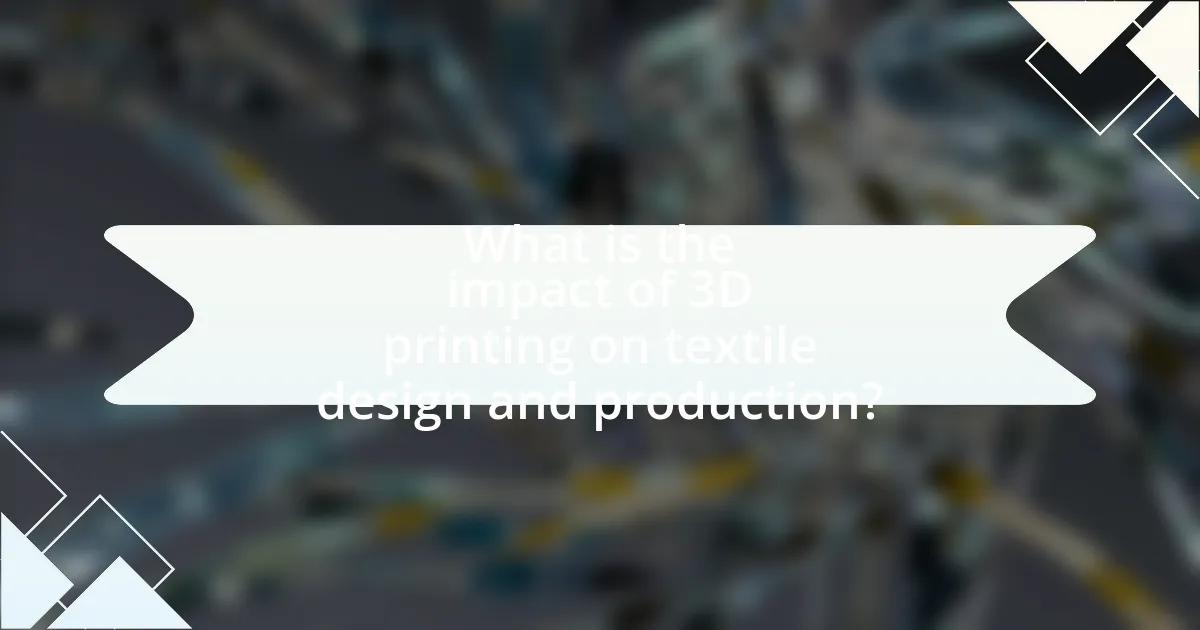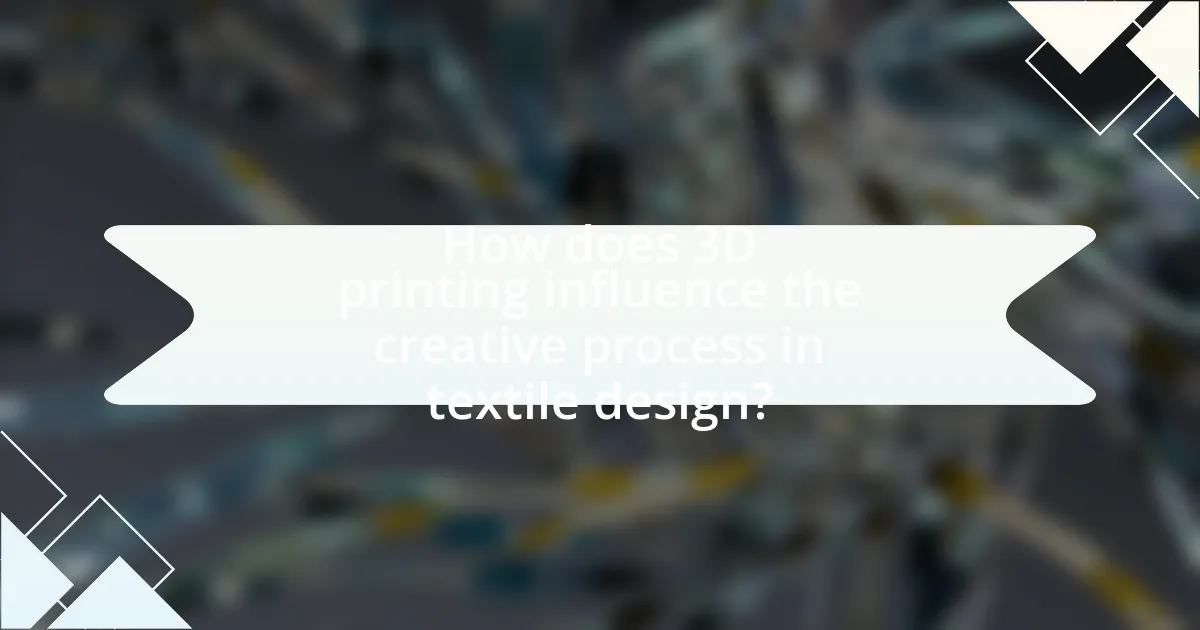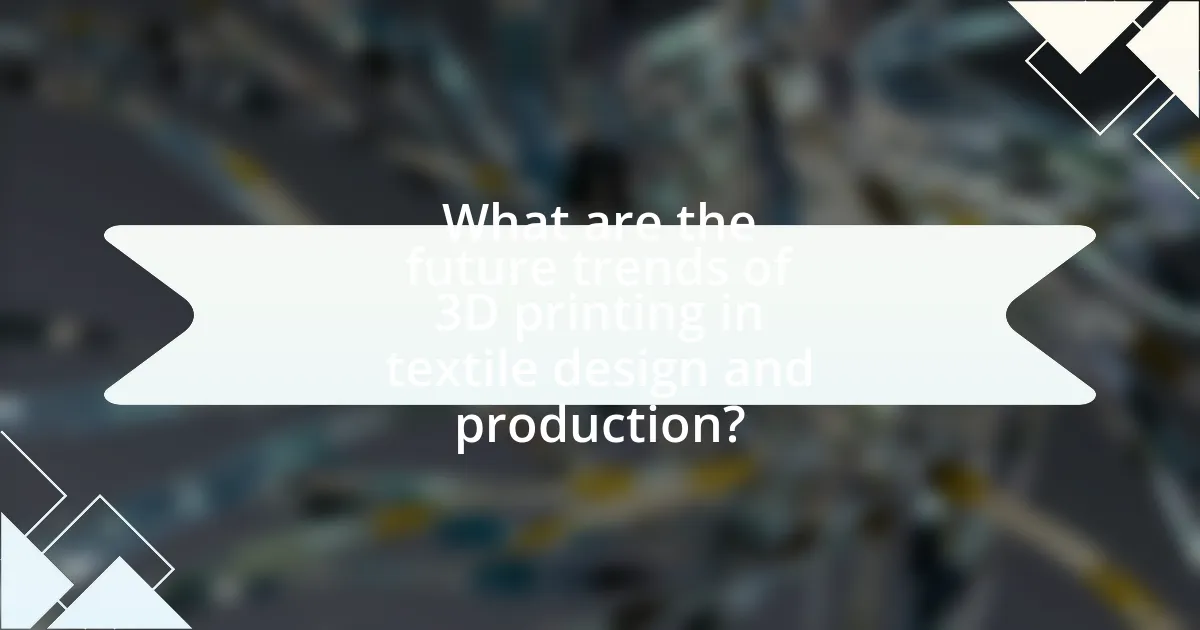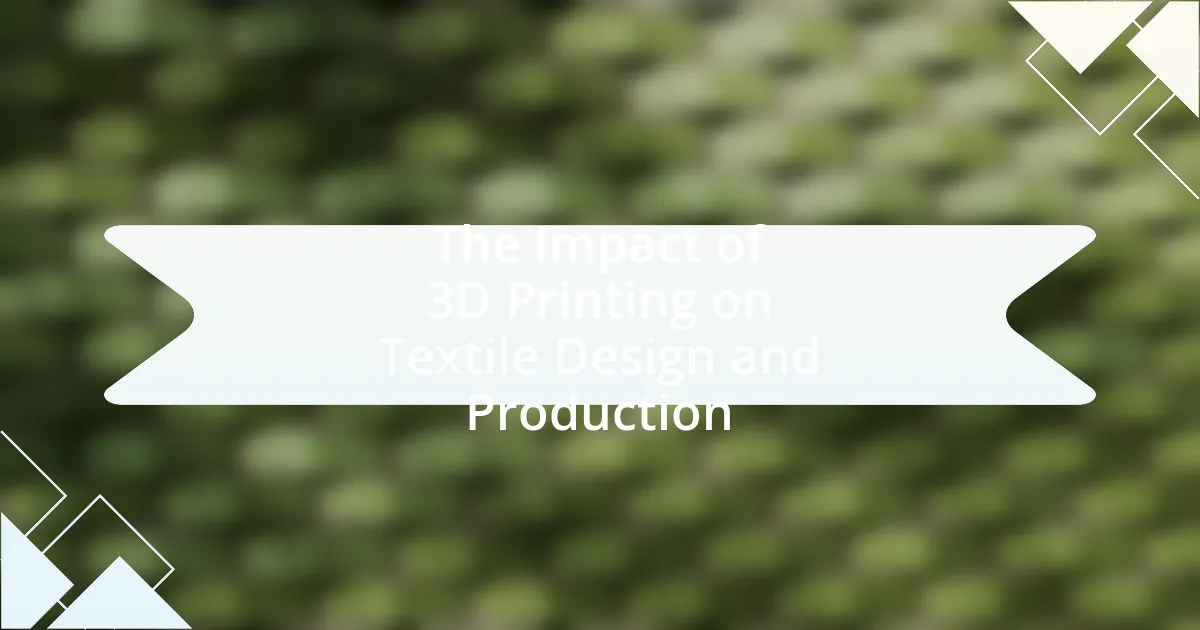The article examines the transformative impact of 3D printing on textile design and production, highlighting its ability to enable rapid prototyping, customization, and the creation of complex structures that traditional methods cannot achieve. Key advancements in materials and printing techniques have expanded the technology’s applications, allowing for intricate designs and enhanced sustainability. The article also addresses the benefits of integrating 3D printing, such as reduced waste and faster production times, while discussing challenges like material limitations and regulatory concerns. Furthermore, it explores future trends, including increased customization and the use of sustainable materials, shaping the landscape of the textile industry.

What is the impact of 3D printing on textile design and production?
3D printing significantly transforms textile design and production by enabling rapid prototyping, customization, and the creation of complex structures that traditional methods cannot achieve. This technology allows designers to produce intricate patterns and textures directly from digital files, reducing material waste and production time. For instance, a study published in the Journal of Fashion Technology & Textile Engineering highlights that 3D printing can decrease lead times by up to 90%, allowing for more agile responses to market trends. Additionally, brands like Adidas have utilized 3D printing to create customized footwear, demonstrating the practical application of this technology in enhancing consumer personalization and sustainability in the textile industry.
How has 3D printing technology evolved in the textile industry?
3D printing technology has significantly evolved in the textile industry by enabling the production of complex, customized fabrics and garments. Initially, 3D printing in textiles focused on prototyping and limited applications, but advancements in materials and printing techniques have expanded its use to include fully functional clothing and accessories. For instance, companies like Adidas have utilized 3D printing to create intricate shoe designs that enhance performance and reduce waste, showcasing the technology’s potential for mass customization and sustainability. Additionally, innovations such as digital textile printing have allowed for more efficient production processes, reducing lead times and costs while offering designers greater creative freedom.
What are the key advancements in 3D printing for textiles?
Key advancements in 3D printing for textiles include the development of new materials, enhanced printing techniques, and integration with digital design tools. New materials such as flexible filaments and bio-based polymers have expanded the range of textures and functionalities in textile applications. Enhanced printing techniques, including multi-material printing and improved resolution, allow for more intricate designs and better performance characteristics. Additionally, the integration of digital design tools enables designers to create customized patterns and structures, streamlining the production process and reducing waste. These advancements collectively contribute to the evolution of textile design and production, making it more efficient and innovative.
How do these advancements influence design possibilities?
Advancements in 3D printing significantly expand design possibilities in textile design and production by enabling complex geometries and customized patterns that traditional methods cannot achieve. This technology allows designers to create intricate structures, such as lattice designs and multi-material textiles, which enhance functionality and aesthetics. For instance, 3D printing can produce textiles with embedded sensors or varying textures, offering innovative solutions for fashion and functional applications. Additionally, the ability to rapidly prototype and iterate designs reduces time-to-market and fosters creativity, as designers can experiment with new forms and materials without the constraints of conventional manufacturing processes.
What are the primary benefits of integrating 3D printing in textile production?
The primary benefits of integrating 3D printing in textile production include enhanced design flexibility, reduced waste, and faster prototyping. Enhanced design flexibility allows for the creation of complex patterns and structures that traditional methods cannot achieve, enabling designers to innovate without constraints. Reduced waste is achieved through additive manufacturing, which uses only the material needed for production, contrasting with subtractive methods that often result in excess material. Faster prototyping accelerates the development process, allowing for quicker iterations and adjustments based on market feedback, which is crucial in the fast-paced fashion industry. These benefits collectively contribute to a more sustainable and efficient textile production process.
How does 3D printing enhance customization in textile design?
3D printing enhances customization in textile design by allowing designers to create intricate patterns and structures that are tailored to individual preferences. This technology enables the production of unique textiles with specific textures, colors, and shapes that traditional methods cannot achieve. For instance, a study published in the Journal of Textile Science & Engineering highlights that 3D printing can produce complex geometries and personalized designs on-demand, significantly reducing lead times and waste associated with conventional textile manufacturing processes. This capability not only meets consumer demand for personalized products but also fosters innovation in design, making it a transformative tool in the textile industry.
What cost efficiencies does 3D printing offer in production?
3D printing offers significant cost efficiencies in production by reducing material waste and enabling on-demand manufacturing. Traditional manufacturing processes often result in excess material usage, whereas 3D printing utilizes only the necessary amount of material for each item, minimizing waste. Additionally, 3D printing allows for the production of complex designs without the need for expensive molds or tooling, which can drastically lower initial setup costs. According to a study by Wohlers Associates, 3D printing can reduce production costs by up to 90% in some cases, particularly for low-volume and customized items. This efficiency not only lowers the overall cost of production but also accelerates the time to market, further enhancing economic benefits.
What challenges does the textile industry face with 3D printing?
The textile industry faces significant challenges with 3D printing, primarily related to material limitations, production speed, and scalability. Current 3D printing technologies often struggle to replicate the diverse textures and properties of traditional fabrics, limiting their applicability in high-quality textile production. Additionally, the speed of 3D printing processes is generally slower compared to conventional manufacturing methods, which can hinder mass production capabilities. Furthermore, scaling 3D printing for large-scale textile production remains a challenge due to the high costs of equipment and materials, as well as the need for specialized skills to operate and maintain the technology effectively. These factors collectively impede the widespread adoption of 3D printing in the textile sector.
What are the technical limitations of 3D printing in textiles?
The technical limitations of 3D printing in textiles include material constraints, resolution issues, and scalability challenges. Current 3D printing technologies often struggle with a limited range of suitable materials, as many traditional textiles cannot be effectively replicated with 3D printing filaments. Additionally, the resolution of 3D printed textiles may not match the fine detail and texture achievable through conventional textile manufacturing methods, leading to a lack of aesthetic appeal. Furthermore, scalability remains a significant hurdle; while 3D printing is effective for prototyping and small-scale production, it is not yet efficient for mass production, which limits its application in the broader textile industry.
How do regulatory and sustainability concerns affect 3D printing adoption?
Regulatory and sustainability concerns significantly hinder 3D printing adoption in the textile industry. Regulations often require compliance with safety, environmental, and quality standards, which can complicate the integration of 3D printing technologies. For instance, the European Union’s REACH regulation mandates that manufacturers ensure their products do not contain harmful substances, impacting the materials used in 3D printing. Additionally, sustainability concerns drive demand for eco-friendly practices, leading companies to evaluate the environmental impact of 3D printing processes and materials. A study by the Journal of Cleaner Production found that while 3D printing can reduce waste, the energy consumption and material sourcing still pose challenges to achieving sustainability goals. These regulatory and sustainability factors create barriers that slow down the widespread adoption of 3D printing in textile design and production.

How does 3D printing influence the creative process in textile design?
3D printing significantly influences the creative process in textile design by enabling designers to rapidly prototype and iterate their ideas. This technology allows for the creation of complex patterns and structures that would be difficult or impossible to achieve through traditional methods. For instance, designers can experiment with various materials and textures in a digital environment, leading to innovative designs that push the boundaries of conventional textile production. Additionally, 3D printing facilitates customization, allowing designers to tailor products to individual preferences, which enhances creativity and personal expression in textile design.
What new design methodologies are emerging from 3D printing?
New design methodologies emerging from 3D printing include generative design, topology optimization, and digital fabrication techniques. Generative design utilizes algorithms to create complex structures that meet specified performance criteria, allowing designers to explore a wider range of possibilities than traditional methods. Topology optimization focuses on material distribution within a given design space to enhance performance while minimizing weight, which is particularly beneficial in textile applications. Digital fabrication techniques enable the direct translation of digital designs into physical products, streamlining the production process and reducing waste. These methodologies are supported by advancements in software and hardware, which facilitate rapid prototyping and customization, ultimately transforming the textile design and production landscape.
How does 3D printing facilitate rapid prototyping in textile design?
3D printing facilitates rapid prototyping in textile design by enabling designers to quickly create and test complex patterns and structures. This technology allows for the production of intricate designs that would be difficult or impossible to achieve with traditional methods, significantly reducing the time from concept to prototype. For instance, 3D printing can produce samples in a matter of hours, compared to weeks or months required for conventional prototyping techniques. Additionally, it allows for immediate modifications to designs, fostering an iterative design process that enhances creativity and innovation in textile development.
What role does software play in 3D textile design?
Software plays a crucial role in 3D textile design by enabling designers to create, visualize, and manipulate textile patterns and structures in a virtual environment. This technology allows for precise modeling of fabrics, facilitating the exploration of complex designs that would be difficult or impossible to achieve through traditional methods. For instance, software like CLO 3D and TUKAcad provides tools for simulating fabric behavior, texture, and draping, which enhances the design process and reduces material waste. Additionally, these software solutions often integrate with 3D printing technologies, allowing for direct translation of digital designs into physical products, thus streamlining the production process and fostering innovation in textile design.
How are designers adapting to the integration of 3D printing?
Designers are adapting to the integration of 3D printing by incorporating advanced software tools and materials that enhance design flexibility and production efficiency. This adaptation allows for the creation of complex structures and customized designs that were previously difficult or impossible to achieve with traditional manufacturing methods. For instance, designers are utilizing parametric design software to generate intricate patterns and forms that can be directly translated into 3D-printed textiles, enabling rapid prototyping and iteration. Additionally, the use of sustainable materials in 3D printing aligns with the growing demand for eco-friendly practices in the textile industry, further driving innovation.
What skills are necessary for designers to effectively use 3D printing?
Designers need skills in 3D modeling, material science, and an understanding of additive manufacturing processes to effectively use 3D printing. Proficiency in software such as CAD (Computer-Aided Design) is essential for creating detailed 3D models, while knowledge of different materials, including polymers and metals, is crucial for selecting the right material for specific applications. Additionally, familiarity with the 3D printing process, including printer operation and post-processing techniques, enhances a designer’s ability to produce functional and aesthetically pleasing designs. These skills collectively enable designers to innovate and optimize textile production through 3D printing technology.
How are educational institutions responding to the demand for 3D printing skills?
Educational institutions are increasingly integrating 3D printing skills into their curricula to meet the rising demand for these competencies. Many universities and colleges are offering specialized courses and degree programs focused on additive manufacturing technologies, which include hands-on training with 3D printers and software. For instance, institutions like the Massachusetts Institute of Technology (MIT) and the University of Southern California have established dedicated labs and research centers for 3D printing, emphasizing its application in fields such as textile design and production. This shift is supported by industry trends indicating that 61% of manufacturers report a skills gap in 3D printing, prompting educational bodies to adapt their programs accordingly to prepare students for the evolving job market.

What are the future trends of 3D printing in textile design and production?
The future trends of 3D printing in textile design and production include increased customization, sustainable materials, and integration with smart technology. Customization allows designers to create unique patterns and fits tailored to individual preferences, enhancing consumer engagement. Sustainable materials, such as biodegradable filaments and recycled fibers, are gaining traction as the industry seeks to reduce environmental impact. Additionally, the integration of smart technology, such as sensors and conductive threads, is expected to lead to the development of interactive textiles that respond to environmental stimuli. These trends are supported by advancements in 3D printing technology, which enable more complex designs and efficient production processes, ultimately transforming the textile industry.
How is consumer demand shaping the future of 3D printed textiles?
Consumer demand is significantly shaping the future of 3D printed textiles by driving innovation in customization, sustainability, and production efficiency. As consumers increasingly seek personalized products, companies are responding by utilizing 3D printing technology to create unique designs tailored to individual preferences. For instance, a report by SmarTech Analysis indicates that the market for 3D printed textiles is projected to grow substantially, fueled by consumer interest in bespoke fashion items. Additionally, the demand for sustainable practices is prompting manufacturers to explore eco-friendly materials and processes, aligning with consumer values around environmental responsibility. This shift is evidenced by brands like Adidas, which has introduced 3D printed shoes made from recycled ocean plastic, showcasing how consumer preferences are influencing material choices and production methods. Overall, consumer demand is a critical factor driving the evolution of 3D printed textiles, leading to more innovative, sustainable, and personalized products in the market.
What innovations are expected in materials used for 3D printing textiles?
Innovations in materials for 3D printing textiles are expected to include the development of bio-based polymers, advanced composites, and smart textiles. Bio-based polymers, such as PLA (polylactic acid), are gaining traction due to their sustainability and biodegradability, which aligns with the growing demand for eco-friendly materials in the fashion industry. Advanced composites, incorporating materials like carbon fiber or glass fiber, are anticipated to enhance the strength and durability of 3D printed textiles, making them suitable for a wider range of applications. Additionally, smart textiles that integrate sensors and conductive materials are being explored to create garments capable of monitoring health metrics or responding to environmental changes, thus expanding the functionality of textile products. These innovations are supported by ongoing research and development efforts in material science, aiming to improve the performance and versatility of 3D printed textiles.
How might 3D printing change the landscape of sustainable fashion?
3D printing could revolutionize sustainable fashion by enabling on-demand production, which significantly reduces waste associated with traditional manufacturing processes. This technology allows designers to create garments and accessories with precision, minimizing excess material usage and energy consumption. According to a study by the Ellen MacArthur Foundation, the fashion industry generates over 92 million tons of waste annually, much of which could be mitigated through the adoption of 3D printing techniques that promote a circular economy. Additionally, 3D printing facilitates the use of sustainable materials, such as biodegradable filaments, further enhancing the environmental benefits of fashion production.
What practical steps can businesses take to implement 3D printing in textile production?
Businesses can implement 3D printing in textile production by first investing in appropriate 3D printing technology, such as Fused Deposition Modeling (FDM) or Selective Laser Sintering (SLS), which are suitable for creating textile components. Next, they should develop or acquire specialized software for designing 3D models tailored to textile applications, enabling customization and innovation in designs. Additionally, businesses must establish partnerships with material suppliers to access advanced 3D printing filaments and fabrics that meet industry standards for durability and flexibility. Training staff on 3D printing processes and design software is crucial to ensure effective implementation. Finally, conducting pilot projects to test and refine the production process will help businesses identify challenges and optimize their approach, as evidenced by companies like Adidas, which successfully integrated 3D printing into their production line for customized footwear.
What are the best practices for integrating 3D printing into existing workflows?
The best practices for integrating 3D printing into existing workflows include assessing current processes, training staff, and establishing clear objectives. Assessing current processes allows organizations to identify areas where 3D printing can enhance efficiency or creativity, such as prototyping or custom designs. Training staff ensures that team members are proficient in operating 3D printers and utilizing design software, which is crucial for maximizing the technology’s potential. Establishing clear objectives helps align 3D printing initiatives with business goals, ensuring that the integration supports overall production and design strategies. These practices are supported by industry reports indicating that companies that effectively integrate 3D printing see significant improvements in product development timelines and customization capabilities.
How can businesses measure the success of 3D printing initiatives in textiles?
Businesses can measure the success of 3D printing initiatives in textiles by evaluating key performance indicators (KPIs) such as cost savings, production speed, material efficiency, and customer satisfaction. For instance, a study by Wohlers Associates reported that companies utilizing 3D printing in textiles can reduce production costs by up to 30% and significantly decrease lead times, allowing for faster market entry. Additionally, tracking the reduction in waste material generated during the printing process can provide insights into sustainability improvements. Customer feedback and sales data can also indicate the market acceptance of 3D-printed textile products, further validating the initiative’s success.

Leave a Reply